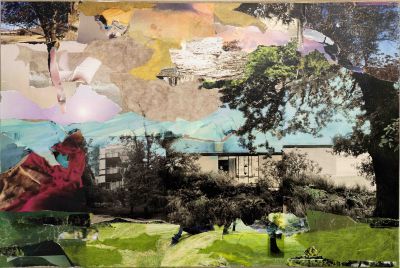AN EXTENSION OF THE BATTLE ZONE OR A HOPE-FILLED LANDSCAPE? On Joanna Buchowska’s painting with paper

“There is nothing that cuts you down to size like coming to some strange and marvellous place where no one even stops to notice that you stare about you.”
R. Adams, Watership Down, 1972
“He was part of my dream, of course – but then I was part of his dream, too!”
L. Carroll, Through the Looking Glass, 1871
Painting is often seen as the most humanistic field of visual creativity. How, therefore, can it be succinctly defined? Perhaps as a kind of illusoriness, an attempt to perceive the world through the energy that is inherent in colour and form? Certainly, it is also a question of convention, since it is material, and demands knowledge and skill. What can one say about contemporary painting when critics claim that its prospects are weak, while others are of the view that after years of installations, digital photography, video art, body art and actionism of all kinds, centuries-old traditional painting is regaining its respectability? Are there any boundaries at all that still apply to painting today? It appears that since artists have discovered new ways of using this medium, contemporary painting is no longer restricted by technical forms. Only its most essential feature, namely that of two-dimensionality, as well as other qualities such as colour arrangement and composition, remain. Certainly, a peculiar disintegration of form would appear to correspond to the disintegration of the world today. What abilities should painters still have apart from talent and technical skill? Above all, the capacity to create an expression for their own individuality. The peril of art is no doubt its repeatability, since everything has already been done in the past... However, what has already existed in one form or another can still be re-interpreted and differently combined. A new quality can be achieved from the collision of often opposite elements.
The collage was already used in imperial China, yet this term only became a consciously used form of artistic expression in modern art with the surrealist works of Max Ernst. Put simply, the collage is the creation of one’s own composition of a new work, which is produced by combining fragments of different materials – usually paper, sometimes also scraps of fabric. As a rule, collages are one-dimensional, but they can also take the form of a relief. The sculptural version is an assemblage, for which items are alienated from their original purpose of use and are altered in accordance with the artist’s intentions. The French verb coller means “to glue”. But can gluing also constitute painting? Transformation forms a counterweight to repeatability, to the avoidance of the attempt to quote oneself; it is a decisive step forwards. You can never entirely foresee what the impact will be of a break with the technical characteristics of a familiar medium and a subsequent radical change to the previous creative process. That is why the determination by Joanna Buchowska to one day make a new start, to leave her comfort zone, to give up everything associated with the practice that had brought her success to date – namely painting at the easel – is not an emotional artistic gesture that highlights the form, but rather an impressive declaration of creative maturity. It took her many years to make such a step. It required a masterful command of her craft (of which several of the classic artists might be envious!), then the development of a fully self-assured approach to her achievements to date, in other words, the awareness and distinctiveness of her individual form. Thus, transformation becomes a means of artistic survival, and the choice of collage, and painting with collage, her alternative take on modernity and independence as a painter.
Joanna personifies candour and purest enthusiasm, both in life and in art. Should she therefore have remained immobile in the face of a rapidly changing reality? Not with her temperament! Her originality is a resource in itself, which counters banality. She has changed her technique, but not her artistic form of narration. Her art continues to stand out for its sensorial approximation both to the depicted world and to the viewer, whom she likes and respects. And as before, in her current work, there is no space for pointless special effects, stylistic tricks or the filling of empty space with a play of forms that has not been thought through. With a full command of the “trusted material”, she is aware of what happens in her images, and for what purpose, since her work is always created according to its own conditions.
Her new language of communication is accessible and seductive, as was her painting with colours not such a long time ago. By observing reality through the prism of her own perspective, she does not disregard the three basic features of painting and, following the theory of Kandinsky, she retains point, line and plane. She glues cut-outs from newspapers, magazines and paper of all types onto the image carrier and uses Indian ink, ink, marker pens, and sometimes acrylic paint. Of course she varnishes. Sometimes, even... with nail varnish. If you look at her work close up, you can see outstanding composition, almost without visible joins. That’s how the extraordinary magic of her pictures works. But what, in fact, is a picture? Some people are attracted by its monetary appeal, while for others, it has a taste of adventure and the continual discovery of a wondrous existence in a parallel world, through which Joanna Buchowska guides us without any of the ever-present haste, with genuine passion and with heartfelt emotion. She comments on this world without words, using colour and composition. For her, even the search for this one piece of paper that is needed for the next vision is already a highly exciting journey and the start of a dialogue with the viewer.



















